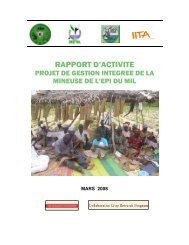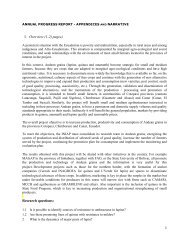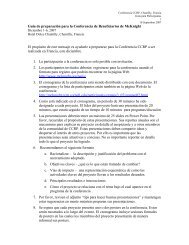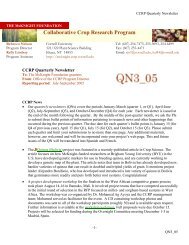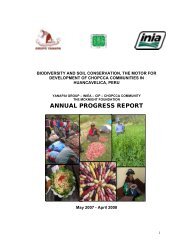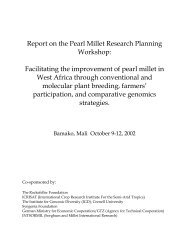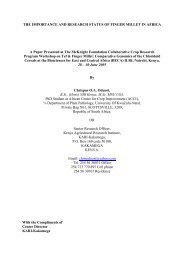English - McKnight Foundation Collaborative Crop Research Program
English - McKnight Foundation Collaborative Crop Research Program
English - McKnight Foundation Collaborative Crop Research Program
Create successful ePaper yourself
Turn your PDF publications into a flip-book with our unique Google optimized e-Paper software.
<strong>McKnight</strong> <strong>Foundation</strong> <strong>Collaborative</strong> <strong>Crop</strong>s <strong>Research</strong> Project No: 06-741<br />
Although IT97K-825-15 had the least Alectra infestation at all on-farm sites it was the least preferred by<br />
the farmers. At all sites farmer’s variety was the latest, and it had not even flowered when all the other<br />
entries were maturing.<br />
It was noted that only early maturing varieties were most preferred, forgetting the advantage of late<br />
maturing varieties for having other traits such as prolonged availability of leaves as relish. This suggests<br />
that there is a need to evaluate the materials according to maturity groups.<br />
Cowpea and pigeon pea as the main source of vegetable protein in the project target sites; it was<br />
observed that early maturity of the cowpea bridge the hunger period of February/March, while waiting<br />
for the pigeon pea to mature late in the season.<br />
Wrap up:<br />
- Released varieties showed better yields than test lines<br />
- Early maturing varieties save as source of food in hunger periods<br />
- Seed system for cowpea is very poor<br />
- More cowpea seed should be sent to Balaka and Kasungu districts as there is high demand for seed<br />
of the improved varieties.<br />
- Farmers in Rivirivi recommended forming farmer research groups for better access by researchers<br />
and extension staff as compared to individual isolated farmers<br />
TANZANIA<br />
27 th -30 th April, 2009<br />
Introduction: The monitoring and evaluation tour for Tanzania was done in three regions (Iringa,<br />
Dodoma, and Morogoro) from 27 th to 30 th April, 2009. The tour involved visiting seed multiplication,<br />
on-farm, on-station, and crossing activities. The objective was to monitor progress in implementing<br />
agreed strategies and action plans for the project. This report gives information on sites/farmers/stations<br />
visited, varieties evaluated, team observations and way forward.<br />
The monitoring and evaluation team comprised the following:<br />
Ambonesigwe Mbwaga (Project Leader) ARI, Uyole Mbeya Tanzania<br />
Joseph Mligo (Breeder) ARI, Ilonga Kilosa Tanzania<br />
Vernon Kabambe (Striga specialist) Bunda College, Lilongwe, Malawi<br />
James Bokosi (Breeder) Bunda College, Lilongwe, Malawi<br />
Boukar Ousmane (Breeder,) IITA Nigeria<br />
On-farm visits: A number of farmers groups were visited in the two regions (Iringa, and Dodoma). In<br />
general farmers were required to plant five IITA lines and two locally released varieties (Fahari and<br />
Vuli-2). The two released varieties showed to be more adapted and performed consistently well across<br />
locations despite the prevalence of drought in many locations. The major problem is that they are both<br />
susceptible to Alectra. In a participatory variety trial conducted at Mpunguzi, Dodoma region, farmers<br />
selected IT 00K-126-3 as the best entry despite being susceptible to Alectra. Many of the farmers<br />
visited showed dedication to running the on-farm trials.<br />
On-station visits: The first on-station trial visited was at Ismani. The trial had 14 entries replicated four<br />
times. Each plot had five rows of four meter length. Although drought had an impact the performance<br />
of the entries was far better than the farmers’ fields. Alectra pressure was not as high as the previous<br />
year. This could have been due to the prolonged dry spell during the growing season. Vuli-2 and Fahari<br />
performed very well despite sustaining some Alectra plants. Except for the two check entries the rest<br />
had no Alectra emergence. The second trial was at Bihawana (Bihawana farmers training centre). The<br />
entries were similar to those planted at Ismani but four extra entries. Rainfall distribution was not good.<br />
The site received a mere 250 mm (normal 330 -488 mm) of rainfall between February (151.3mm) and<br />
March (98.8mm) and poorly distributed. This site had the heaviest infestation of Alectra and is good for<br />
13<br />
2009



